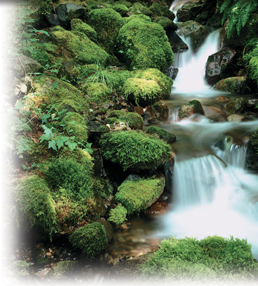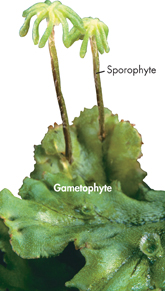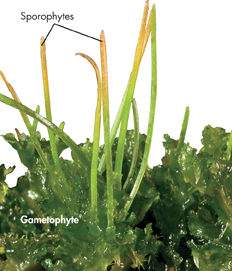Bryophytes

KEY CHARACTERISTICS
Bryophytes (BRY oh fyts), found mostly on land, are multicellular plants that lack true vascular tissue. This lack of vascular tissue limits their height to just a few centimeters and restricts them to moist soils.
Organization Complex and specialized tissues, including protective external layers and rhizoids
Movement Adults stationary; male gametes swim to egg cells using flagella.
Water Transport Diffusion from cell to cell; in some mosses, water flows through specialized tissue.
Reproduction All reproduce sexually with alternation of generations, producing gametes and spores. Most reproduce asexually, too. The gametophyte stage is dominant, with the sporophyte stage dependent on the gametophyte.

Mosses thrive in shady, damp locations, such as along the banks of this Oregon creek.
Although they are listed together here, the three major groups of bryophytes are now considered to have evolved independently from each other.
MOSSES: Classic bryophytes
Mosses are found on damp, well-shaded soil, and occasionally along the sides of tree trunks.

LIVERWORTS
Liverworts are flat, almost leaflike plants that grow on the damp forest floor. Some species are shaped almost like the liver, from which they get their name.

HORNWORTS
Hornworts get their name from their sporophytes, tiny green structures resembling horns. Like other bryophytes, hornworts are found mostly in damp, well-shaded areas. Only about 100 species are known.

Table of Contents
- Formulas and Equations
- Applying Formulas and Equations
- Mean, Median, and Mode
- Estimation
- Using Measurements in Calculations
- Effects of Measurement Errors
- Accuracy
- Precision
- Comparing Accuracy and Precision
- Significant Figures
- Calculating With Significant Figures
- Scientific Notation
- Calculating With Scientific Notation
- Dimensional Analysis
- Applying Dimensional Analysis




